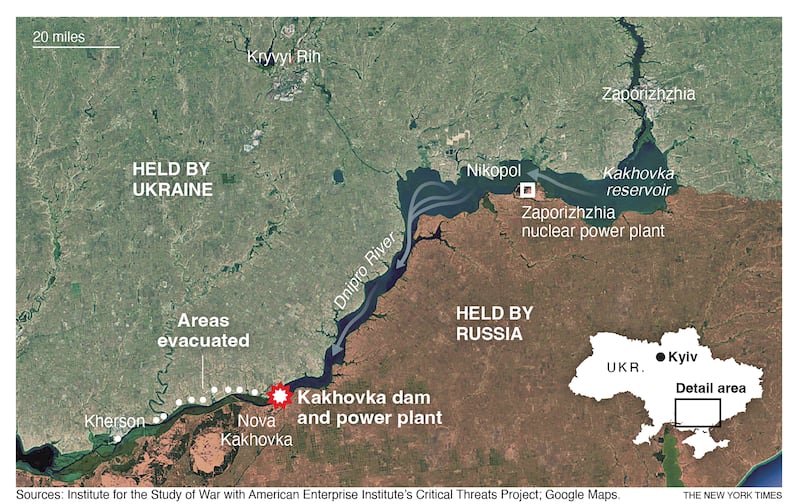For decades, Ukraine’s southern Kherson region was a destination for nature lovers, home to at least 70 species of animals including many endangered creatures.
But on Tuesday, when the Kakhovka dam broke, its sprawling nature reserves, national parks and popular zoo were “completely washed away”, said Julia Markhel, head of the environmental non-governmental organisation Let’s Do It Ukraine.
The fate of wildlife caught up in the spreading torrents that followed the dam’s collapse is just one aspect of the still-unfolding disaster, which is set to transform the geography and ecology of the region as well as causing further hardship to a population already scarred by war.
“I compare it with the Chernobyl disaster,” said Maksym Soroka, an environmental safety expert at the Dovkola Network NGO – in reference to the Soviet-era nuclear accident that unfolded on Ukrainian territory. “Yes, the consequences are different, but the long-term effect on the population and the territory is the same.”
RM Block
With rescue efforts still under way after the dam’s collapse in the early hours of Tuesday, Ukrainians were trying to assess the longer-term damage to the region’s economy and environment. Officials and experts warned that unique ecosystems might be lost, farmland turned into desert, and remaining water supplies contaminated.
Several hundred tonnes of lubricant and fuel oil were washed into the Dnipro river from the collapse of the Kakhovka hydroelectric plant, as well as landmines unearthed by the torrent.
The flood also polluted groundwater sources, officials said, worsening a shortage of drinking water for local populations. The reservoir provided drinking water for the cities of Kherson and Krivyi Rih as well as the Crimean peninsula via a 400km canal.
The health ministry said a “plague” of rotting fish carcasses, effluent from latrines and contamination from cemeteries poised a serious risk of disease and instructed local residents not to consume water drawn from wells and ground pumps, as is still common in rural Ukraine.

Soroka said he expected an “epidemic of intestinal infections”, adding: “The situation in the occupied territories of the left bank of the Kherson region is even worse. People have no access to medicine and no way to escape this catastrophe. And there is nothing we can do to help them.”
Beyond its immediate humanitarian consequences, the dam breach will deliver a serious blow to the vital farming industry. Ukraine’s agriculture ministry said the loss of the Kakhovka reservoir was a “man-made disaster” for farming in the area, a big cereal and oilseed producing zone where summers are hot and dry.
A highly competitive arable sector was a bright spot in Ukraine’s economy before it was hammered by Russia’s occupation and blockade of Black Sea ports. Global wheat prices climbed by 3 per cent after the dam collapsed as investors digested the implications.
The lake held back by the dam covered 2,155sq km before the barrier was breached, and contained 18 cubic kilometres of water. It provided irrigation for 584,000 hectares of arable land in the Dnipropetrovsk, Kherson and Zaporizhzhia regions, which produced four million tonnes of grain and oilseed crops in 2021.
With the reservoir drained, Kherson, an arid region in the far south, has lost 94 per cent of its irrigation, Zaporizhzhia 74 per cent, and Dnipropetrovsk 30 per cent.
“This was a huge irrigation system in which Ukrainian farmers had invested billions of dollars after the fall of the Soviet Union,” said one executive at a large agricultural company. “It is all gone.”

Denys Marchuk, the deputy chair of the Ukrainian Agrarian Council, a trade association, told Ukrainian television the dam’s destruction could cost the country up to 14 per cent of its grain exports. A third of the country’s beets, onions, cabbage and carrots – ingredients for the national dish of borschch – are produced in the region, he added.
“We will not be able to grow anything in the Kherson region until the [dam] is restored,” Marchuk said. Building a new dam could take several years even without an ongoing war.
Markhel, the environmental activist, said that “mini-deserts” could begin to form in Kherson, causing further droughts.
The disappearance of the dam has also ended the navigability of the Dnipro between the city of Zaporizhzhia and the Black Sea, a cheap form of transport for crops and industrial goods. The Kakhovka reservoir was also a vital source of water for heavy industry, including big steel and metallurgy plants in Nikopol and Krivyi Rih.
The agricultural ministry said 95,000 tonnes of fish could be lost. A video shared online by Andriy Yermak, President Volodymyr Zelenskiy’s chief of staff, showed thousands of fish flopping around on a dry riverbed on the banks of Maryanske village, Dnipropetrovsk region, 90km upstream from the destroyed dam.
Ihor Syrota, director general of Ukrhydroenergo, the hydroelectric operator, said on Wednesday it might still be possible to save part of the Kakhovka reservoir with water at depths of 3 metres (down from 16 metres) depending on whether the base of the dam remained intact.
“We will see this in two or three days,” he said. “But we understand that it’s most likely the dam will be completely destroyed.”
– Copyright The Financial Times Limited 2023



















